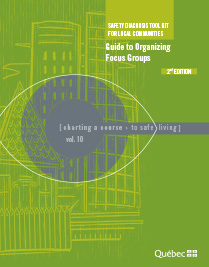Safety Diagnosis Tool Kit for Local Communities: Guide to Organizing Focus Groups – 2nd edition
A focus group is a group discussion led by a facilitator. Participants are asked to share their thoughts on a particular topic, based on their personal opinions and experience. They are also encouraged to react to the views expressed by other participants and to say where they stand in relation to those views.
In the model proposed in this guide, focus group participants are selected on the basis of criteria that ensure the life setting under study is well represented. This approach guarantees that the groups provide a wide range of viewpoints and perceptions, and can thus help to shed light on the different opinions and degree of consensus that exist on a given topic, such as the feeling of safety in a regional county municipality (RCM) or a municipality. In safety diagnoses, focus groups are used primarily to gather the opinions and perceptions of a population about the following safety-related topics: the safety of a particular life setting, the feeling of safety, and problems that cause concern, be they disorder, incivility, crime or victimization. Safety diagnosis focus groups can also be used to discuss the quality of public services. Several focus group sessions may be needed to enable all potential participants to take part in the discussions. It may be a good idea to get in touch with them through local organizations.
Main characteristics of focus groups held within the context of safety diagnoses
Objectives
- Help identify crime and safety problems as they are perceived by the population or their representatives.
- Highlight viewpoints that are more explicit or more deeply rooted in a specific context than information gathered through closed questionnaires.
- Elicit the opinions of several stakeholders or groups so as to gain a better grasp of the similarities and differences between their opinions.
Advantages
- May provide a better understanding of the reasons behind the situations observed.
- Involve different stakeholders who might be mobilized for future action.
- Shed light, through participant interaction, on the dynamics between different groups in the study area.
- Offer flexibility in gathering data from different groups.
- Can be organized at little cost.
Disadvantages
- Can deal with only a limited number of topics at a time (no more than three or four per session).
- Do not constitute the most appropriate forum for discussing certain topics (e.g. violent victimization).
- Do not necessarily provide a representative portrait of the life setting concerned.
Comments
- Require specific expertise for analyzing qualitative data.
- Require skilled facilitators to ensure that all participants have a chance to express themselves openly.
- Entail variable costs depending on the number of focus groups organized and the expertise available for analyzing the qualitative data collected during the sessions.
Prior to setting up a focus group, your project team must give some thought to the kind of information they would like to obtain. They must try to answer the question: “What do we want to learn?” Team members must then clearly establish the goals of the focus group and the topics that will be discussed. They must also think about which groups will be invited to take part. Once again, your team must try to answer the following questions: “Which groups are more likely to provide us with information on the questions that are of interest to us?” “Which groups cannot be contacted with other data collection methods?” In short, setting up a focus group involves careful planning and organization.


